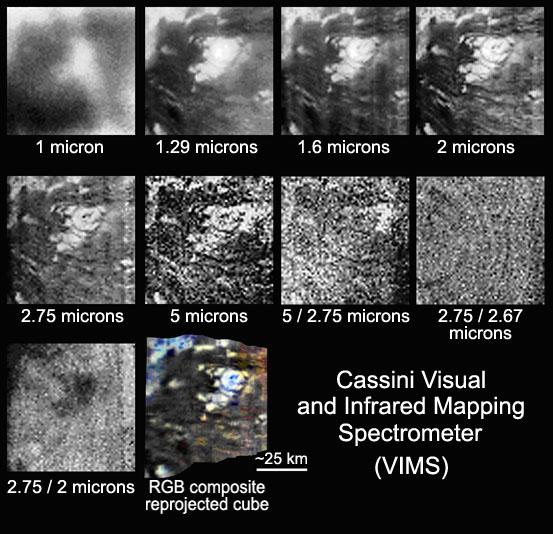Titan Volcano in Several Infrared Wavelengths

| PIA Number | PIA07963 |
|---|---|
| Language |
|
Details of the circular feature, which scientists think is an ice volcano, which could be a source of methane in Titan's atmosphere, show up at wavelengths larger than 1.3 microns (a micron is one-millionth of a meter; a meter is 39 inches).
The first six panels are images of the feature taken in six infrared windows. Images made up of two colors (ratio images) are represented in order to visualize compositional variations, which appear to be slight. The last panel is a color composite image (red, 2.75 micron; green, 2.0 micron; blue, 1.6 micron). These images were acquired with Cassini's visual and infrared mapping spectrometer, designed to peer through Titan's thick haze to the surface.
Titan, Saturn's largest moon, is the only known moon to have a significant atmosphere, composed primarily of nitrogen, with methane (methane is about 2 to 3 percent) as the largest remaining component. One goal of the Cassini mission is to find an explanation for what is replenishing and maintaining this atmosphere. This dense atmosphere makes the surface very difficult to study with visible-light cameras, but infrared instruments like the visual and infrared mapping spectrometer can peer through the haze. Infrared images provide information about both the composition and the shape of the area studied.
These images were taken during Cassini's Oct. 26, 2004, flyby of Titan.
The Cassini-Huygens mission is a cooperative project of NASA, the European Space Agency and the Italian Space Agency. The Jet Propulsion Laboratory, a division of the California Institute of Technology in Pasadena, manages the mission for NASA's Science Mission Directorate, Washington, D.C. The Cassini orbiter and its two onboard cameras were designed, developed and assembled at JPL. The visual and infrared mapping spectrometer team is based at the University of Arizona.
For more information about the Cassini-Huygens mission visit http://saturn.jpl.nasa.gov . The visual and infrared mapping spectrometer team homepage is at http://wwwvims.lpl.arizona.edu.
Credit:NASA/JPL/University of Arizona
